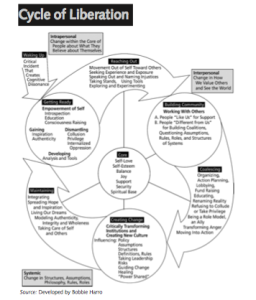Chart developed by Bobbie Harro (School of Human Services, Springfield College), circa MM.
The hub of this freedom wheel brings me back to one of my favorite Alan Watts essays, “Play and Survival,” in which the great Zen guru defines his version of the “spiritual base” like this: “Each one of us is a flowing, and if you resist it, you go crazy. You are like somebody trying to grab water in his [sic] hands — the harder you squeeze it, the faster it slips through your fingers.”
We’re daily reminded of our perpetual “flowing” when the efficiency gurus push us ever closer to the crazy zone. Of course Watts is talking here about a different kind of “resistance,” the kind that makes it tough (down in the core) to engage in this struggle with any kind of sustained energy. Key to our process (and therefore our “cycle”) is knowing when to go with the flow — maintaining balance — and when to do whatever it takes to stop (obstruct, derail or at least slow) the action.
Anyway I like this liberation rubric and the overall flow from “critical incident” to spreading hope — with solid stretches of coalition building, action planning, anger management and policy transformation along the way.
Watts would remind us to enjoy the ride, too. Play and survival. Or this earlier in the same essay: “Life is like music for its own sake.”
